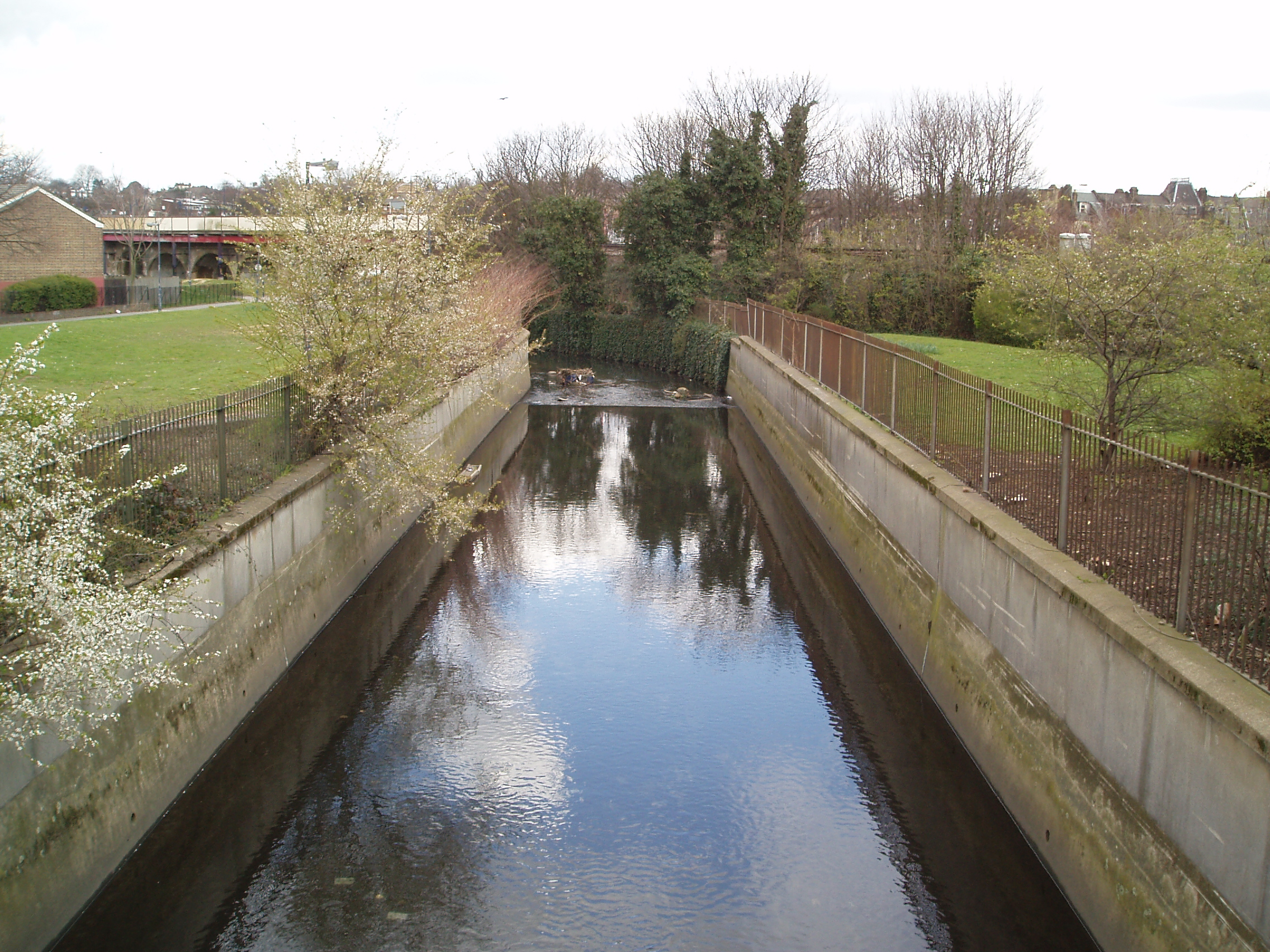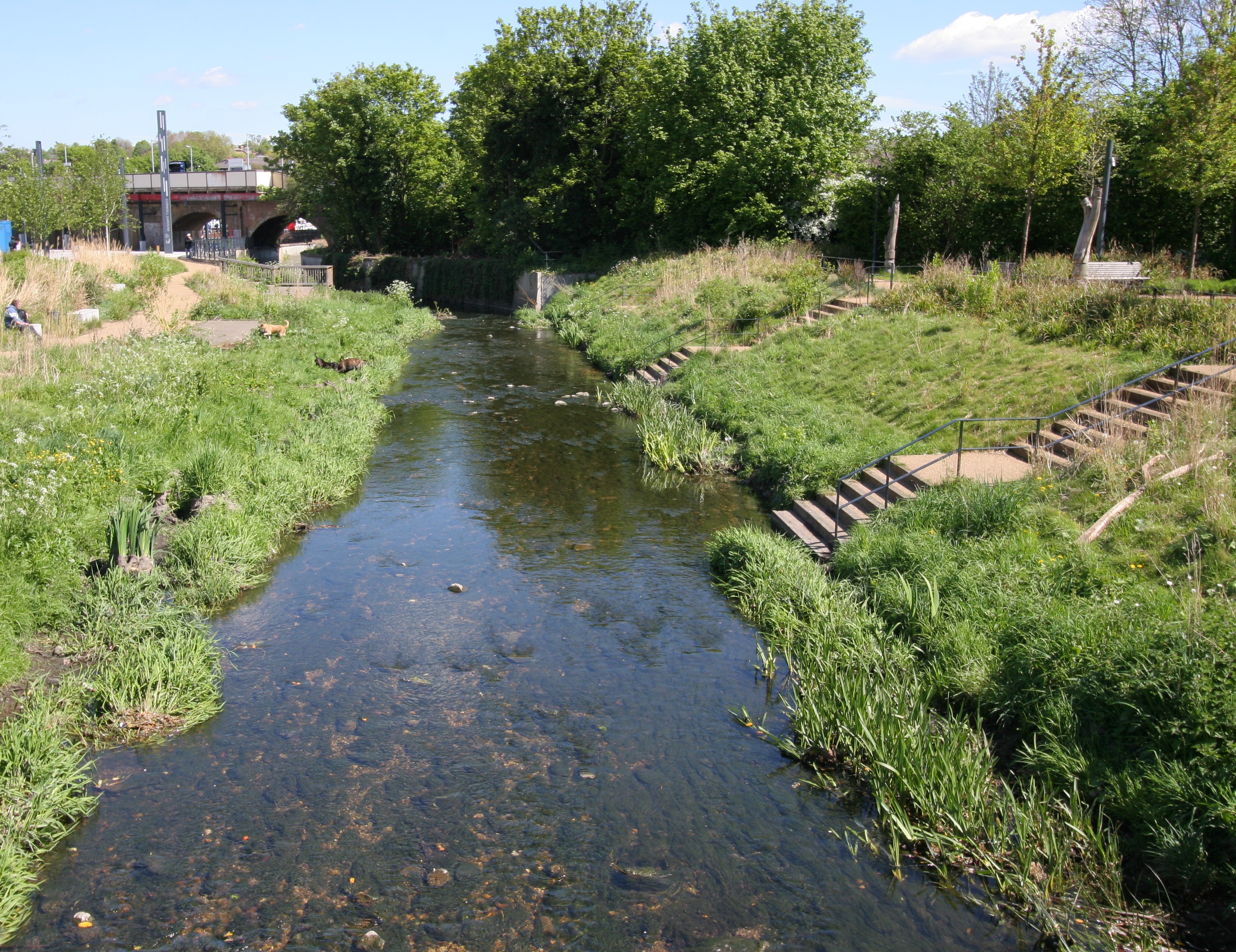

River Ravensbourne at Cornmill Gardens, Lewisham, London
“Open an area up, make it safer and more pleasant to visit, encourage wildlife to thrive in it, and you’ll find people’s whole outlook on their local environment can be transformed…Connect parks up and improve them for everyone’s benefit and crime levels go down…”
Environment Agency: Better Places overview
Rivers and society
For centuries society has interacted with rivers. They are an integral part of our local environment on which we historically depended for food, shelter and basic survival. Over time urbanisation has degraded rivers, modern society has become less connected to our local environment and people’s perception of rivers has changed. Traditional river based activities (e.g. milling) have been lost and urban development has meant culverted and channelised rivers. Many people are unaware of the locations of their local rivers and parks and open spaces are often the only places where urban rivers are visible.
A healthy environment is known to improve quality of life. Restoring rivers helps to provide quality environments and puts people in closer contact with nature. In urban environments this is particularly relevant, as restoring rivers can provide people with much needed green space, to offer people a place away from stresses and strains often associated with cities– with a higher density of people, poor air quality due to vehicle emissions, poor housing and lack of green space1.
River restoration counters these pressures through a wide range of social benefits:
• Physical and Mental well-being
• Recreation
• Social cohesion
• Aesthetic
• Education
• Cultural
Physical well-being
Many river restoration schemes on public parks have resulted in increased park usage, for longer periods, and an increase in sports and games. Research shows that regular physical activity helps reduce the risk of developing a range of serious diseases and improves overall quality of life. Many people are failing to meet recommended levels of activity which has led to an increase in obesity and coronary heart disease.
River restoration in public open spaces offers free, accessible and safe recreation for children and adults. Post project research has highlighted renewed appreciation for and interaction with the natural environment, particularly where parks were previously regarded as unsafe due to antisocial behaviour. Often the river was too steep, deep and unsuitable for children to paddle in. A local resident and visitor to Chinbrook meadows in South London said “London is a concrete jungle and places like this are like your lungs of London... it’s your own little countryside.” 2
Mental well-being
Society has recognised the benefits of the environment on mental health for centuries. More recently there is evidence that contact with nature and living things makes people feel good and positively enhances their mental well-being while contributing to stress reduction. “Green exercise” refers to the synergistic benefit of participating in physical activities, whilst being directly exposed to nature. Reports have also demonstrated the value of outdoor activities in helping to combat depression and increasing happiness and wellbeing and confidence. “Less green nature means reduced mental well-being, or at least less opportunity to recover from mental stress. As natural green environments have increasingly come under pressure from economic development our own wellbeing has suffered as a consequence. Today, stress and mental ill-health are becoming more common, and the associated public health costs are growing”3
Recreation
River corridors can provide opportunities for recreation as part of daily life allowing stress relief and enjoyment as well as activities such as fishing, cycling and watching wildlife. In built up areas river corridors enable safe, cost effective and healthy commuting which further contributes to physical health.
River restoration schemes can facilitate recreation and learning. In Merthyr Tydfil, Wales, children restored fish to the stretch of river and as a result were found to care more about their environment, take up a new outdoor activity and feel happier.4
Social cohesion
Rivers can play a vital role in the community by encouraging social interaction and bonding. Restoring a river between two estates can enable two separated communities to mix. Voluntary groups cantered on protecting their river corridor bring communities together in positive action to look after their local area fostering a community spirit, pride in the environment and a sense of belonging.
Aesthetic
River restoration improves the aesthetics of the environment by restoring natural landscape features and benefiting the associated flora and fauna, creating nicer surroundings. People wish to experience wildness yet feel safe in urban areas. Post restoration improvements in social behaviour such as reduced graffiti and littering further improve aesthetics and foster a sense of pride in the local environment.
Education
Restoration schemes provide huge learning potential about our natural world helping to demonstrate how humankind depends on water and the need to reduce our collective impact on the environment. Key lessons include the water cycle, climate change adaptation, the threats of invasive species and the ecology of our native species and habitats. Studies have shown schoolchildren learning about wildlife and natural habitats from their site visits were motivated to do something differently in their everyday life to help the environment.
Cultural
Rivers have always been part of our culture with human settlements located adjacent to rivers for transport, fishing, farming and recreation. Restoring our cultural links to rivers is a long term goal and an important part of all drivers raised above. Many religions connect spiritual and religious values to rivers and the earth, and landscapes have long provided inspiration for art, folklore and architecture.